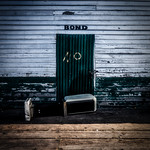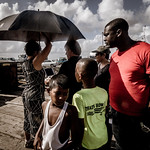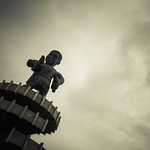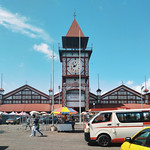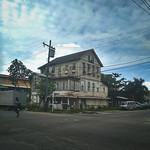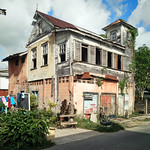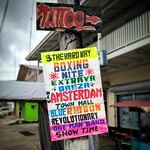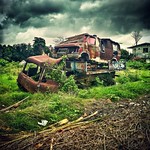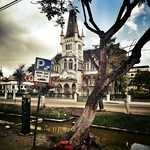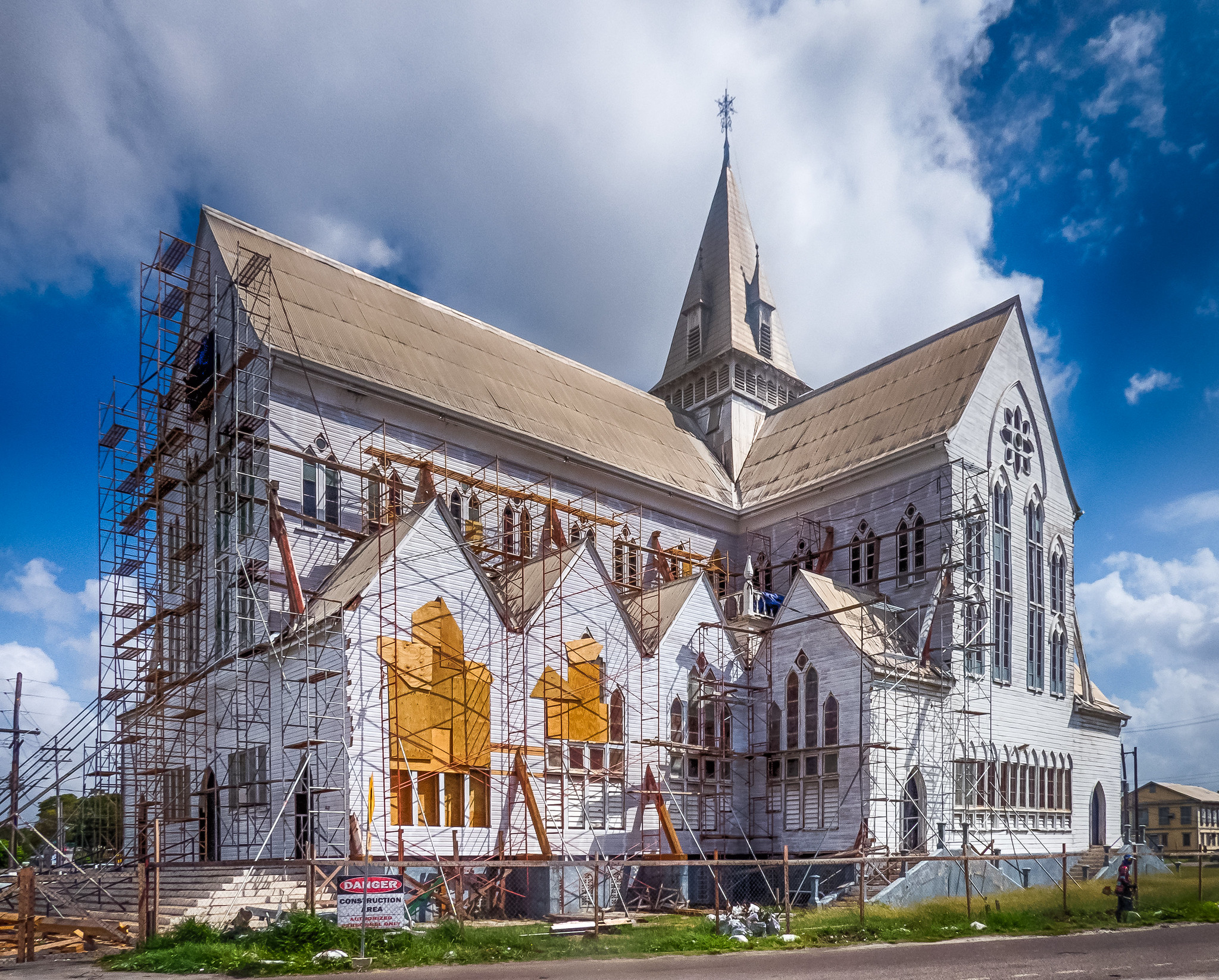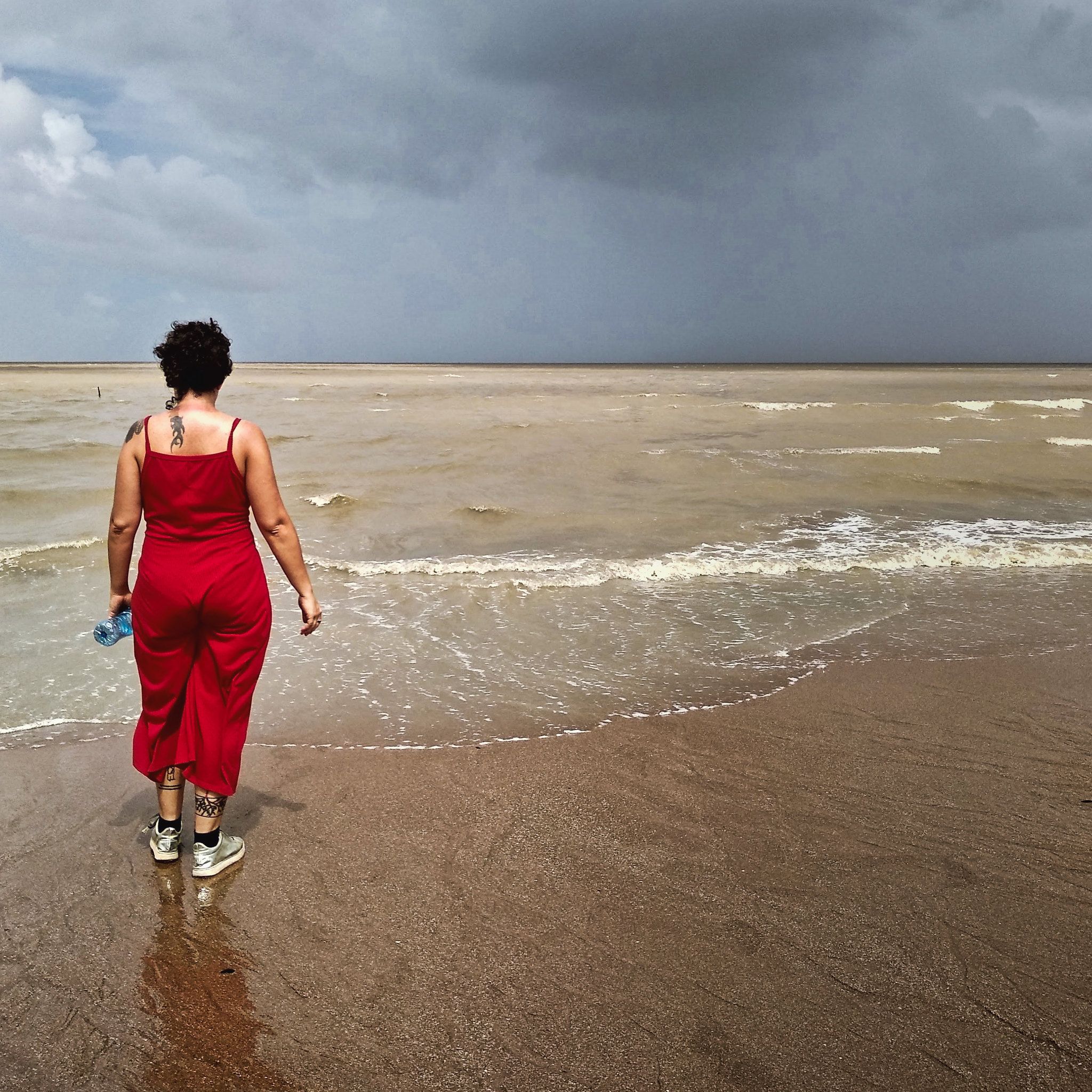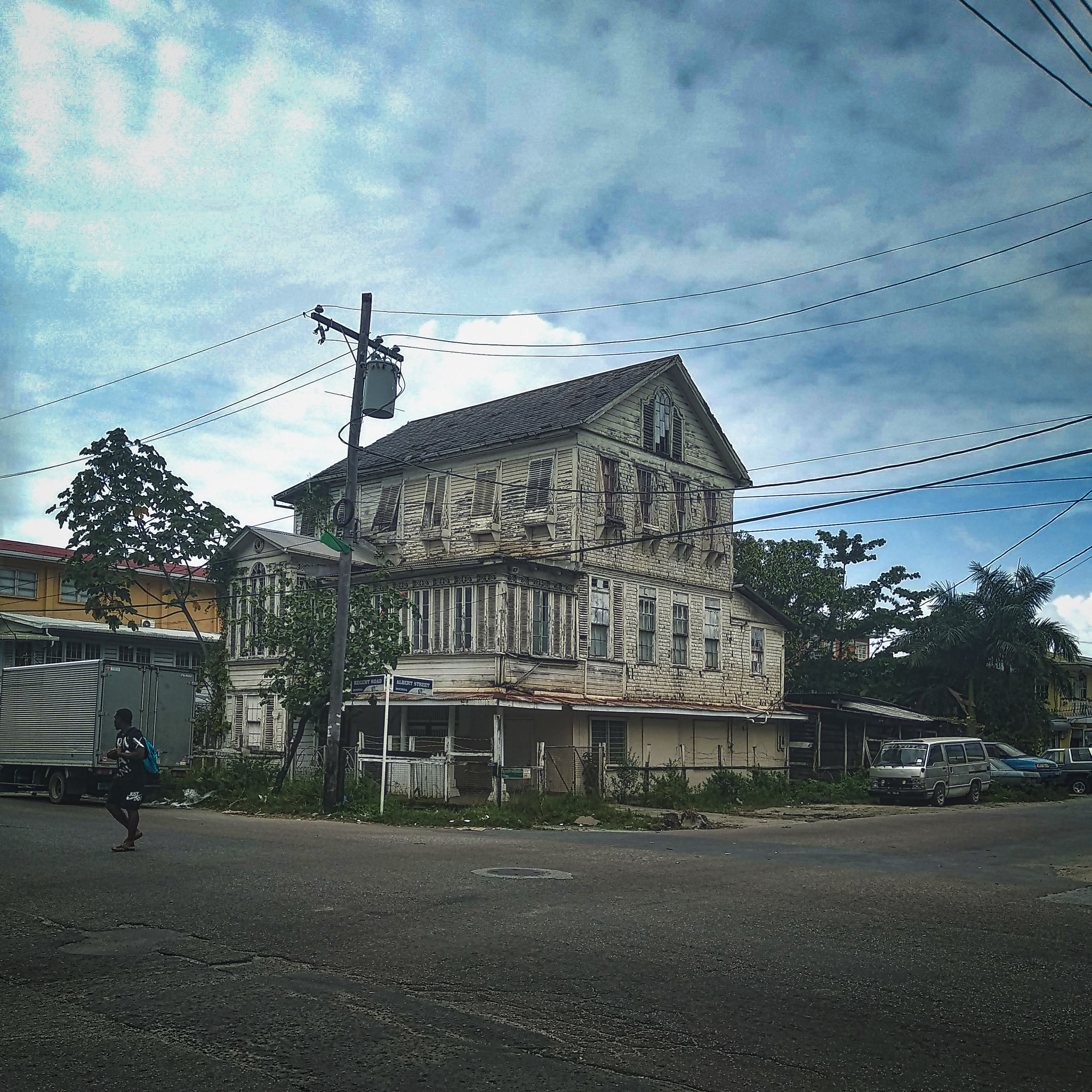In the city named after the first king of Hannover
Georgetown, the capital of Guyana, is a sleepy town filled with wooden houses in various states of decay. A town that, you would be excused to think, time has almost forgotten. The little economic activity of the last 100 years or so has resulted in the city being somewhat caught in a time warp, which in itself should be a reason for considering elevating the city’s old town to World Heritage status, something that the city of Paramaribo, next door in neighbouring Suriname, has managed to achieve.
As shaky proof of this time warp, Guyana is one of the 53 members of the Commonwealth, is a statue of Queen Victoria, which stands in front of the city’s high court. Defaced, Victoria lacks a nose and a hand, the statue having been dynamited in the 1950 by anti-colonialists. Then, earlier in 2018, also under anti-colonial sentiment, the statue was doused in red paint. Both, as good an inspiration as any for working towards getting rid of royalty the world over.
Before Victoria, it was her grandfather, George III, who gave his name to what became Georgetown, in 1812. Before that, under the Dutch, it was called Stabroek, after the Dutch ‘lord of Stabroek’, Nicolaas Geelvinck, who was also president of the Dutch West Indies Company. The original Stabroek is in Belgium, in the province of Antwerp, just on the border with the Netherlands.
Before the Dutch, the French briefly occupied the town, calling it Longchamps (‘large fields’), after the Brits briefly had taken over from the Dutch, who had first settled on an island in the nearby Demerara river.
George III was also the king of Hannover (in Germany), from 1813 onwards, while Germany was still a patchwork of states. He had already been the ‘Elector’, sort of like a prince, of Hannover before that, but after struggling to retain the area during the French Revolutionary Wars and, eventually, the dissolution of the Holy Roman Empire in 1806, a new title of the ruler of this area was agreed upon and George became king of Hannover.
George’s family had been maintaining property in what is now Germany for generations, but they struck it lucky when George’s great-grandfather, George I, became king of Great Britain and Ireland in 1714, when the British crown switched from the House of Stuart to the House of Hannover, after in 1701, the parliament of England (and in 1707, that of Scotland) had decreed that no papist, that is, Roman Catholic, could hold the British crown.
So, the prince of Hannover, the nearest non-catholic family member of the departed Anne, became king of England, and his great-grandson, first king of Hannover, was the inspiration for naming this small settlement on the mouth of the Demerara river in what is now Guyana. Victoria, missing her nose and hand in Georgetown, and Elizabeth II, are direct descendants of the Georges, and thus of the house of Hannover, even though Edward VII, Victoria’s son, first changed it to the house of Saxe-Coburg-Gotha, in 1901, in honour of the house of his father, the husband of Victoria, while Edward’s son then changed it to house of Windsor in 1917, to disassociate themselves from the Germans during the first world war.
Incidentally, the Hannover metropolitan area, today, has significantly more people than the whole country of Guyana.
Water management
In honour fo the moral standing of the British royal family, much of Georgetown lies below sea level. Relevant, as it also borders the Atlantic Ocean, if culturally strongly leaning towards the Caribbean. A one meter high sea wall is supposed to keep out the waters, which only most of the time it’s actually able to.
A clever system of sluices, called ‘kokers’, closing at high tides, opening at low tides, keeps the city dry. A word of obvious Dutch extraction, the use of kokers appears to date back only to the mid 19th century, long after the Dutch had lost control of the area. Then again, the prevalence of Dutch names all over the country strongly suggest Dutch farmers, which would be Dutch slave owners, were around for much longer. The kokers (‘tubes’ or ‘cylinders’), canals dug alongside the plantations, were used to drain the rectangular fields, caught between the sea or river and the wet hinterlands. It means that even a modern scene of outdoor Georgetown could, if you just pinch your eyes a bit, be mistaken for the Dutch countryside.
Plenty houses in Guyana have landscape paintings on the walls, depicting typical Guyanese landscapes. You have to look twice to notice that the sluices and wooden houses don’t occupy the northern hemisphere, but depict a scene from the outskirts of Georgetown.
It’ll be lonely, this Christmas
We arrived in Georgetown on Christmas day, at the end of the afternoon. The town was deserted, everything was closed, except for a few dodgy street-side bars with a few drunken stragglers hanging on, both on the floor, knocked out, and the stools. Many of the wooden houses nearly falling apart, it felt like we had walked into a post-apocalyptic dystopia.
Our driver from Lethem, Sankar (“Sankar, I need to pay you for our ride!”, “Oh, yeah, I forgot.”), dropped us off in front of our hotel, but there, a guard, intoxicated, a half-finished bottle of rum next to him, told us that he, too, had been waiting for the owner to show up the whole day. Paul, the owner, answered none of the phone numbers I had of him, while the guard had lost his cellphone in the half-covered ditch in front of the hotel, the guard regularly stealing longing glances to his now disappeared communication device. “I’m not sticking my hand in there!”
The hotel was closed, room keys were not available, the streets were deserted, the hotel owner was not answering his phones, dusk was setting in and Georgetown has a bad reputation for high crime rates. We needed a solution quick.
But, already, we had started to experience what might be the one defining feature of Guyana, its amazingly friendly and accommodating people, in stark contrast to the country’s reputation of a crime-ridden backwater. Figuring out where to get alternative accommodation, with pretty much every single hotel in the downtown area being closed, several Guyanese helped us out in finding a solution. And it worked; we ended up in a huge wedding cake of a house in one of the suburbs, where we hung out with a friendly Brexiteer who flew drones and took 360 videos for local clients.
Perhaps it’s related to so very few tourists coming this way, but we not once experienced attempts at being ripped off in situations where this would be typical almost anywhere else. Literally everyone was great, while plenty would also warn us to be careful when walking around: “Don’t take anything you’re not prepared to lose!”.
But though Georgetown isn’t a city that is too well suited for walking, when we did, we felt in no way threatened.
But, things will change, now that a recently discovered oil field is set to come online in 2020.
Already, oil companies have started buying up property for the processing of oil. Apartments, closed condominiums, have been built and more are being constructed and property prices are going up. A general consensus seems to be that the Guyanese do not expect that a reasonably portion of the future proceeds will benefit the Guyanese people.
Likely, this influx of well-paid foreigners will create a two-tier society where outsiders will consistently be seen as walking money bags. Already suffering from a long-running brain drain, those that have staid will prefer high paying, but low-skilled, jobs in the oil industry over jobs that match their qualifications in low-paying, but understaffed sectors. The GDP per capita will rise significantly, but the money will stick to the elite or will leave the country.
The Brits and their coups
While the US and the UK conspired and overthrew the democratically elected prime minister of Iran in 1953, paving the way for stronger control of the country by the shah, which eventually lead to the islamic revolution of 1979, the UK also overthrew the elected government of British Guiana in the same year.
Churchill feared that the leftist president, Cheddi Jagan, and his American wife with Eastern European roots, Janet, would turn the colony communist. Churchill was hoping for American support, who were unhappy with another perceived communist threat in their backyard, but in the end, Britain acted alone, mounting a military operation codenamed Operation Windsor (why not Hannover, or Saxe-Coburg-Gotha?). Churchill dispatched a warship and brought hundreds of troops by air and sea to secure key sites and Britain then suspended British Guiana’s constitution, fired its legislators and arrested the Jagans.
Though even with the elections that brought the Jagans to lead the country, power never had left the hands of the appointed British governor. However, now, and for the three years that followed, the governor ruled using emergency powers, while the Jagans were kept under house arrest, incidentally a stone’s throw away from where we were staying in Georgetown.
With Cuba turning communist, the Americans stepped in to make sure that Cheddi Jagan would not be the first leader of a post-independence Guyana in 1966, though Jagan did become premier in 1961, and then president from 1992 to his death in 1997, after which his wife took over until 1999.
The latter sounds unreasonably nepotist, as Janet, at that time, had already become the longest serving member of the Guyanese parliament, with a total of 46 years under her belt, while also having been minister of two different portfolios in the 1950s and 1960s.
Janet resigned the presidency for health reasons in 1999, eventually passing away in 2009 in Belém, Brazil, while visiting the city for medical care.
Sugar and slaves
The Demerara River, which is today spanned by the Demerara bridge, a floating bridge that, when built, was the longest floating bridge in the world, was the center of the colony when managed by the Dutch. The Brits shifted the center from an island in the river to the shore, but, the shift of the colony’s economy from trade to sugarcane was kept in motion, eventually the colony lending its name to a currently popular alternative to refined sugar, Demerara sugar.
Demerara sugar is a light brown, partially refined, sugar produced from the first crystallisation during processing cane juice into sugar crystals, similar to what you’re left with if you’d leave your glass of cane juice in the sun, letting all water evaporate. Demerara has a caramel-like flavour.
Funnily enough, the bulk of Demerara sugar today is produced on the island of Mauritius.
Back in Demerara, the colony changed hands a few times between the Dutch and British, with the Brits permanently taking control in 1803. The sugarcane plantations expanded, but the treatment of slaves worsened. This eventually lead to the Demerara slave revolt of 1823, which was put down with significant violence.
Word spread back to the homeland and, as a direct consequence, Britain ordained easing the treatment of slaves in the colonies, eventually resulting in the abolishment of slavery in the colonies in 1834.
Plantation owners of British Guiana received a well documented £4,297,117 10s. 6½d. in compensation for the loss of 84,915 slaves. This was part of the 20 million pounds pledged by the British state, a debt which was only fully paid off in 2010.
New Amsterdam and Suriname
Between Georgetown and the Surinamese border, the small town of New Amsterdam was founded after the nearby Fort Nassau was abandoned by the Dutch in favour of Fort Andries, much closer to sea and more practically located for shipping out plantation goods. Fort Andries, then New Amsterdam, developed quickly enough, but saw a slave revolt in 1763 which eventually lead to the burning down of New Amsterdam, after which focus of the colony shifted to the Stabroek, Georgetown.
The slave revolt was run by a West African slave called Cuffy (a bastardisation of Kofi, probably indicating the man was from the area now occupied by Ghana), who killed himself after a fallout with one of his commanders, which ended in a civil war which Cuffy lost. The anniversary of the Cuffy slave rebellion, 23 February, has been Republic Day in Guyana since 1970.
We stopped in New Amsterdam, hoping to find some colonial history. But, though the town is pleasantly sleepy, it has little to offer. We continued on to Suriname, where the process of the ferry crossing of the Courantyne river took much of the day. We left very early, as it wasn’t clear how often and when the ferry ran. Only in Suriname did we get some clarity: The ferry runs once a day, scheduled at 9 (though we didn’t leave until 10:15), and runs again later in the day if there are still cars waiting on the Guyanese side.
The ferry is in bad shape. It only started running some 15 years ago, but even the ferry’s website is admitting they’re having trouble, apparently because the Surinamese are not paying their dues. One of the engines needs replacing, but instead of getting a new engine, a tug boat now pushes the ferry around.






